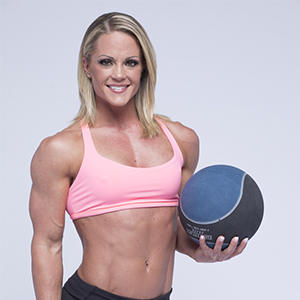By Nicole
Cardio is one of those things most people have a love-hate relationship with – they love the results and that feeling of accomplishment when you’re done, but they hate having to spend hours every week on the treadmill or stepmill to keep body fat at bay.
Thankfully, you don’t have to spend that much time on any cardio machine to burn fat and have a healthier physique – you can get an equally effective cardio workout in half the time.
STEADY-STATE CARDIO
This is typically what you think of when you hear the word cardio. Just go to your gym at peak hours and you’ll see plenty of people walking or jogging on a treadmill (or some other type of cardio machine) at a low-intensity, constant pace for 40–50 minutes, or longer.
Before “cardio” became the common term, this form of exercise was usually called aerobic exercise. Aerobic exercise relies on the pumping of oxygenated blood to the muscles to fuel activity. It also works the cardiovascular system, your heart and lungs (hence the word cardio today). 💓
Studies show that exercising at lower intensity burns a higher percentage of fat as fuel, while training at higher intensity levels burns more carbohydrates than fat. However, that doesn’t mean that your body burns more fat. It means your body is more efficient at using fat for fuel. Also, lower intensity exercise doesn’t burn as many calories as higher intensity exercise. ☹️
Due to its low intensity, this type of cardio is easier on the central nervous system, and your joints. You can do it more frequently and not risk overtraining. It doesn’t require a lot of concentration, either. You can effectively “zone out” and watch something on your iPad and lose yourself in your favorite show.
On the downside, it can get quite boring. And to really lose fat, you’ll have to log serious mileage and time to burn enough calories. ⌛
HIIT CARDIO
High intensity interval training involves performing an activity at 90-100% maximum effort for anywhere from 30 seconds to 1 minute (or more), followed by 1-2 minutes of rest or low-intensity “active” rest. You repeat this cycle for 15-20 minutes (or longer, depending on your fitness level).
Here’s an example: 1 minute of all-out sprinting followed by 1 minute of walking, then sprinting for 1 minute, walking for 1 minute, and so on for the duration of your cardio session.
Exercising at maximum or near maximum levels is anaerobic and uses carbohydrates (in the form of muscle glycogen) to fuel activity. It also produces lactic acid, that burning sensation in the muscles being worked.
The advantage to HIIT is that you do a lot more work, and burn more calories in a shorter amount of time compared to steady-state cardio. 🙌
In addition, higher levels of growth hormone are released and your metabolic rate remains elevated for a longer period of time following exercise, all which can contribute to greater overall fat loss compared to steady-state cardio. And, while HIIT is not technically aerobic exercise, studies show that it does strengthen your cardiovascular system (just run up a flight stairs at full speed for proof).
BEST OF BOTH WORLDS
While research shows HIIT to be superior to steady-state cardio for burning more calories and fat, that doesn’t mean you should do all HIIT sessions. As with most things in life, too much of a good thing can end being bad for you.
Doing HIIT all the time can take a toll on your central nervous system. This can negatively effect your weight training workouts and impede your overall recovery. Also, I would not recommend HIIT for beginners. It can be too strenuous and eventually turn people off to training. Those coming back after a long layoff should ease back into, too.
I typically recommend performing 2-3 HIIT cardio workouts a week (on non-leg training days) and mixing in steady state cardio workouts on the other days to avoid overtraining.
With that in mind, here are three HIIT cardio workouts you can try. Adjust the intensity levels as necessary based on your own fitness level. As a general rule, I recommend wearing a heart rate monitor and keeping your heart rate between 170-190 beats per minute (bpm) during your high-intensity cardio phases.
For steady state cardio, keep your heart rate between 145-160 bpm.
THE WORKOUTS
(click on workout to enlarge)
Looking for more awesome training and nutrition information? Join NicoleWilkins.com for hundreds of workouts, training and nutrition tips, healthy recipes and more to help you transform your body and reach your fitness goals!
Become a Member Today!
ABOUT NICOLE
 One of the biggest names in the fitness industry, Nicole Wilkins is a world-record holding four-time Figure Olympia Champion and 2012 IFPA Personal Trainer of the Year. Nicole earned her BA in Wellness, Health Promotion and Injury Prevention at Oakland University. The owner and founder of nPower Nutrition, Nicole has helped thousands of people start living a healthier lifestyle and reach their fitness goals.
One of the biggest names in the fitness industry, Nicole Wilkins is a world-record holding four-time Figure Olympia Champion and 2012 IFPA Personal Trainer of the Year. Nicole earned her BA in Wellness, Health Promotion and Injury Prevention at Oakland University. The owner and founder of nPower Nutrition, Nicole has helped thousands of people start living a healthier lifestyle and reach their fitness goals.





